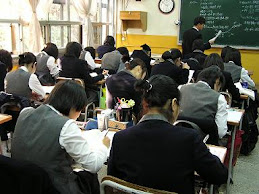In Korea...
Otherwise known as the "Triangle of Death," there are three main factors that
determine whether a South Korean student in his/her final year of high school
can be admitted into a college/university.
1. GPA
High schools in South Korea divide their GPA into Ranks 1 through 9, where Rank 1 is the most difficult to maintain. Typically, students must be within the top 4% of their high schools in order to receive a Rank 1.
2. College Entrance Exam: Suneung
Only students in their last year of high school are allowed to take this exam, which is offered every fall. The exam tests knowledge in mathematics, both the Korean and English languages, and either Social Studies or Science. On the day of the test, TV/radio broadcastingstations take the time to wish the students luck, adults are encouraged to be late to work in order to ensure minimal traffic in the morning,and parents spend the entire day praying for their children. Many people claim that this test does not appropriately reveal students' skills or knowledge.
3. College Entrance Exam: Nonsul
Unlike the Suneung exam, this exam is neither standardized nor run by the government. Instead, colleges/universities prepare a different exam each year for their prospective students.This exam is to be taken a few weeks after the Suneung exam, and the most competitive colleges/universities have been notoriously known to give extremely difficult exams.
-------------------------------------------------------------------------------------------------
In America...
As a Korean-American, I don't have to go through the stress of passing all of those exams in Korea, there are 6 major components of college admissions in the U.S.
1. Challenging Schedule
2. Grades
3. Standardized Test Scores
4. Extracurricular Activities
5. Application Essay
6. Letters of Recommendation
Unlike Korea, college admissions in the U.S. is not solely based on academic achievements. Admission officers look for not only a strong GPA but also extracurricular activities and recommendation letters that display students' characters. As a current junior in high school, I've been told that grades cannot and do not determine college admissions. Although grades represent a substantial portion of the admission process, the application essays and recommendation letters are constantly emphasized. Thus, I may even go so far as to say that whereas Korean colleges/universities look for outstanding grades, American colleges/universities heavily emphasize qualities of strong character, leadership, and service in their students.
Korean students are so bound by the numbers of their test scores. Consequently, when Korean families immigrate to the U.S., the parents usually pressure their kids to stand out as academically bright students with exceptional grades. The U.S. Census 2000 Brief on educational attainment shows that Asian students have surpassed any other race in completing college and achieving a Bachelor's or Advanced degree (Source: http://www.census.gov/prod/2003pubs/c2kbr-24.pdf).
-Alice C.
